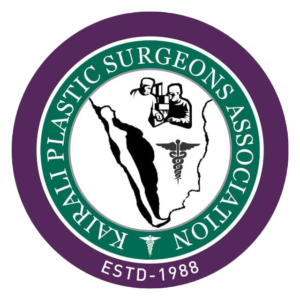
- Abdominal Wall Reconstruction
- Acute Trauma Management
- Breast Reconstruction
- Brachial Plexus and Peripheral Nerve Surgeries
- Burns And Reconstructive Surgeries
- Chest Wall Reconstruction
- Cleft And Craniofacial Surgeries
- Congenital Deformities
- Diabetic Foot & Its Management
- Gender Confirmation Surgeries
- Hand Surgeries
- Head & Neck Reconstruction
- Micro Vascular surgery
- Negative Pressure Wound Therapy
- Pressure Sore And Reconstructive Procedures
- Regenerative Medicine
- Tissue Expansion
INTRODUCTION:
The concept of tissue expansion has revolutionized the management of many congenital defects, debilitating scars and post burns sequelae. In the face of limited availability of soft tissue cover, tissue expansion has radically transformed plastic surgery, leaving the surgeon far better prospects of reconstruction especially in head, face and neck reconstructions, breast reconstructions, pediatric plastic surgery and burns sequelae management. While it provides skin with near perfect color and texture match, it also assures minimal donor site morbidity.
The most limiting step in bringing the novel concept of tissue expansion to grass root level is the availability, procurement and cost of expander/ implant.
PRINCIPLE:
The placement of an implant underneath the soft tissue intended for expansion and its subsequent expansion leads to an initial ischemia of the expanded tissues which in turn leads to angiogenesis.
Mechanical deformation forces act on the cytoskeleton system and plays a critical role in transforming extracellular mechanical force to intracellular events like activation of protein kinase C and activation of proteins and many growth factors as PGDF, angiotensin II. Increased mitosis causes new cell formation and thus, increased area of skin includes skin recruited form adjacent areas but also includes new skin formation.
TYPES OF IMPLANTS:
- Expander with distal port- The expander has its inflation port with a small inter-bridging segment that allows placement of port a little away from the expander. This allows for minimal risk of implant puncture during inflation. It also has the advantage when overlying skin is thin or when pocket is tight.
- Expanders with integrated ports- This has an added risk of inadvertent puncture of the expander when it is difficult to palpate. Hence the need to locate the port using magnetic or ultrasonic devices which requires skilled staff. Particularly popular for breast expanders where adequate pocket can be created
- Self-inflating expanders- Available largely through Europe (NOT in US ) It contains osmotic hydrocolloids that imbibe extracellular water through the silicon membrane leading to Spontaneous expansion. Usually feasible for very small volume expanders, as control of expansion is not possible.
PROCEDURE-
- INSERTION- This begins with implant selection and planning of the incision.Incisions should be planned bearing in mind the proposed flap- whether transposition flap/ advancement flap / rotation flap. Aesthetic units are reconstructed with the scars placed in most inconspicuous areas. Also, care should be taken to avoid tension on suture lines.
Implant selection- the implant should closely resemble the size and shape of the donor surface. The base of the expander is more important than the volume.
Positioning- for implants with distal port, the port is placed subcutaneously for easy palpation. Bony prominences and areas subjected to pressure on lying down are usually avoided. Also avoid kinking of the tube.
- INFLATION- the implant is partially inflated immediately after the insertion usually to avoid dead space and hematoma/ seroma formation. It also reduces the risk of folds. Serial inflation starts about 1 to 2 weeks post insertion. At an average of 1/10th the volume of the expander is infiltrated in each sitting, usually a weekly schedule. The expander may be expanded to 2- 2 ½ times the expander volume for desired effect. The rate of infiltration may be accelerated or slowed, tailoring to patient specifications. Infiltration should be done at 90° into the port using 23G or smaller needle. Blanching of the skin, patient discomfort are the few indicators of limit of infiltration. More specific indicators using pressure transducers (pressures should be less than 45mm Hg) and oxygen tension monitoring may be used.
Special considerations-
- Tissue expansion in burns-
- Almost always there is inadequate tissue in burns ,thus this has revolutionized the treatment
- Reconstruction may be attempted after all burns have healed and scars matured, usually after 6months to one year.
- Incisions can be placed in previous scars but it should be mature and relatively thick so that extrusion does not occur
- Access incision within normal tissue is preferred
- Use of multiple smaller volume prosthesis is especially useful
- Tissue expansion in children-
- Skin & soft tissue is thinner in children.
- Tissues are better vascularized BUT less resistant to trauma
- Higher complication rate than in adult
- Serial repeated expansion is preferred over excessively large prosthesis – 2,3 or 4th serial expansion
- With exception of scalp, facial areas and neck are difficult
- After age 5, most children cooperate and complications less.
- Tissue expansion over the cranium to be done judiciously and slowly in children below 1 yr
- Depression of cranial bones during expansion may occur before 1 yr of age but usually corrects itself once expander is removed
- Remodelling complete in 2-3 months
- Use external port device for inflation for better compliance.
RISKS:
- Implant failure- usually with large bore needle or inadvertent puncture of the implant. This can be avoided by using 23G or smaller needle only. In case of difficult palpation of distal port, sonographic or radiological imaging may be sought.
- Implant infection- most commonly due to introduction of bacteria during the peri-operative period. Suction drains to avoid hematoma or seroma and antibiotic coverage till drains removed helps prevent infection. Late or persistent cases may require implant removal.
- Implant exposure-
